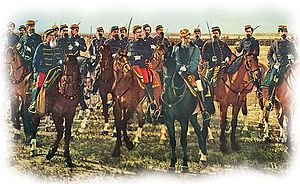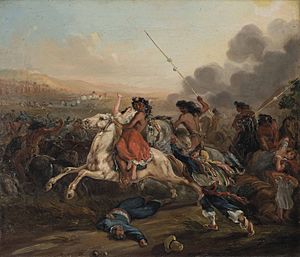Conquest of the Desert facts for kids
Quick facts for kids Conquest of the Desert |
|||||||||
|---|---|---|---|---|---|---|---|---|---|
 Conquest of the Desert, by Juan Manuel Blanes (fragment showing Julio Argentino Roca, at the front) |
|||||||||
|
|||||||||
| Belligerents | |||||||||
Mapuche and Tehuelche allies |
Mapuche tribes
|
||||||||
| Commanders and leaders | |||||||||
| Julio Argentino Roca Conrado Villegas |
Manuel Namuncurá | ||||||||
The Conquest of the Desert (in Spanish: Conquista del desierto) was a major military campaign in Argentina. It happened in the 1870s and was led by General Julio Argentino Roca. The main goal was for Argentina to take control of the Patagonian Desert. This area was home to many native groups.
This campaign helped Argentina expand its land into Patagonia. It also stopped Chile from expanding its own territory there. During this time, Argentine troops caused many deaths among the Mapuche people. Over 15,000 native people were forced to leave their traditional lands. Some were even enslaved.
After the campaign, new settlers, many from Europe, moved into these lands. They used irrigation to grow crops, turning the area into a huge farming region. This helped Argentina become a powerful agricultural country in the early 1900s. A similar campaign happened in Chile, called the Occupation of Araucanía.
The Conquest of the Desert is a very debated topic today. Some people say it was a way to bring progress and civilization. Others believe it was a terrible event that caused great harm to the native people.
Contents
Why it Happened: The Background
When Spanish settlers first arrived in Argentina in the 1500s, they founded the city of Buenos Aires. This led to early conflicts between the Spanish and local native tribes, like the Querandí people. The Spanish bought land around Buenos Aires for raising cattle. This meant less land for the animals the native people hunted, making it hard for them to survive.

Native groups fought back by raiding Spanish towns and taking cattle and horses. In response, the Spanish built forts and launched their own attacks. As more settlers arrived, the border between their farms and native lands slowly moved outwards from Buenos Aires. By the late 1700s, the Salado River was the boundary. Many native people lost their land and way of life. Some had to leave their tribes to work on farms. Others married white settlers, leading to the mixed-race gauchos who worked on ranches.
After Argentina became independent in 1816, its provinces had many disagreements. Once these were settled, the government wanted to quickly claim and settle the lands it believed belonged to Argentina. This was partly to stop Chile from claiming the same areas. Argentina also wanted to grow more food and offer new land to people who wanted to move there.
In 1833, Juan Manuel de Rosas from Buenos Aires Province led attacks against native tribes. Only his expedition had some success. Later, in 1845, Chile founded Punta Arenas in the Strait of Magellan. This worried Argentina because it threatened their claims in Patagonia. Then, in 1861, Chile began its occupation of Araucanía. This made Argentina even more concerned about Chile's growing power in the region. The Mapuche people, who lived in central Chile, had strong connections and spoke the same language as many nomadic tribes on the eastern side of the Andes mountains.
A major event happened in 1872. A native leader named Calfucurá and about 6,000 warriors attacked several Argentine cities. They killed 300 settlers and took 200,000 cattle. These attacks pushed the Argentine government to launch the Conquest of the Desert. The native people would often take stolen cattle from these raids, called malones, to Chile. They traded the cattle for other goods. Some historians believe Chilean officials knew where the cattle came from and allowed the trade. This was because they wanted to increase their influence over Patagonian lands and hoped to claim them later.
Alsina's Plan: A Defensive Approach

In 1875, Adolfo Alsina was the Minister of War under President Nicolás Avellaneda. He presented a plan that he said aimed "to populate the desert, and not to destroy the Indians."
The first step was to connect Buenos Aires to the Fortines (fortresses) with telegraph lines. The government also signed a peace treaty with a native chieftain named Juan José Catriel. However, Catriel broke the treaty soon after. He joined with chieftain Namuncurá and 3,500 warriors. They attacked towns and farms like Tres Arroyos, Tandil, and Azul. This time, the attacks were even worse than in 1872. Catriel and Namuncurá's forces killed 400 settlers, captured 300 more, and took 300,000 cattle.
Alsina fought back, forcing the native groups to retreat. He built new fortines as he moved south to protect the land Argentina had taken. He also built a long trench, 374 kilometers (about 232 miles) long, called zanja de Alsina ("Alsina's trench"). It was three meters (about 10 feet) wide and two meters (about 6.5 feet) deep. This trench was meant to be a fortified border and make it harder for native groups to drive stolen cattle away.
Native groups continued to take cattle from farms in Buenos Aires and Mendoza provinces. But it became harder for them to escape because the animals slowed them down. They also had to face patrolling army units. As the conflict continued, some native groups signed peace treaties. They settled among the "Christians" behind the lines of forts. Some tribes even allied with the Argentine government. They stayed neutral or sometimes fought for the Argentine army. In return, they received regular shipments of cattle and food. When Alsina died in 1877, Julio Argentino Roca became the new Minister of War. He decided to change the strategy.
Roca's Campaign: A Stronger Approach
Unlike Alsina, Julio Argentino Roca believed that the only way to deal with the native threat was to defeat them completely or force them out. He famously said that Argentina needed to deal with "this handful of savages who destroy our wealth." He believed it was important to take control of the rich and fertile lands for Argentina's progress and safety.
In late 1878, Roca began his first major push. He wanted to "clean" the area between Alsina's trench and the Negro River. He did this by constantly attacking native settlements. For example, on December 6, 1878, a group of soldiers clashed with a native war party. In a short but tough battle, 50 native people were killed, 270 were captured, and 33 settlers were freed.
Many armed clashes followed. By December 1878, over 4,000 native people had been captured and 400 killed. Also, 150 settlers were freed, and 15,000 cattle were recovered.
In 1879, General Roca began his second major push. He had 6,000 soldiers armed with new Remington rifles. In just two months, they reached Choele Choel. During this advance, 1,313 native people were killed and over 15,000 were captured. From other areas, army groups moved south to the Negro River and the Neuquén River. These two rivers together formed a natural border from the Andes mountains to the Atlantic Ocean. This attack caused many Mapuche people to move into areas like Curarrehue and Pucón in Chile.
Many new towns were built by European-Argentine settlers along these two rivers. Some were also built on the Colorado River. By sea, some settlements were built on the southern part of the Chubut River. These were mainly by Welsh colonists in a place called y Wladfa.
The Final Push
Roca was elected as the next president after Nicolás Avellaneda. He felt it was very important to conquer the land south of the Negro River quickly. So, in 1881, he ordered a new campaign led by Colonel Conrado Villegas.
Within a year, Villegas conquered the Neuquén Province. He reached the Limay River. The campaign continued to push the native resistance further south. The last major battle happened on October 18, 1884. The very last group of rebels, with over 3,000 warriors led by chieftains Inacayal and Foyel, surrendered two months later in what is now Chubut Province.
In the 1880s, Argentina's advances made it difficult for Chileans and German Chileans to trade with native communities east of the Andes. This meant that leather merchants in Southern Chile had to cross the Andes and start their own cattle businesses. As a result, several Chilean-owned companies were set up in Argentina. They brought workers from Chile, mostly from the Chiloé Archipelago. This is how, in 1895, German Chilean Carlos Weiderhold started a trading post and shop called La Alemana. This place later grew into the city of Bariloche.
Border Clashes
To fight against Argentina's conquest of Patagonia, Chile supplied weapons, ammunition, and horses to their Mapuche allies. On January 16, 1883, a small group of Argentine soldiers was chasing a large native war party. They were ambushed in the Pulmarí Valley by Chilean soldiers. In the fight, Argentine Captain Emilio Crouzeilles, Lieutenant Nicolas Lazcano, and several other soldiers were killed.
On February 17, 1883, Lieutenant-Colonel Juan Díaz, with 16 Argentine infantry soldiers, was following a war party of 100 to 150 native people. When they reached Pulmarí Valley, they were surrounded by the native group and about 50 Chilean soldiers. Even though they were greatly outnumbered, the Argentine soldiers fought bravely. They even charged with bayonets against the Chilean group. On February 21, 1883, according to Argentine Army Major Manuel Prado, 150-200 native warriors with rifles attacked an Argentine Army group near the border. In a four-hour battle, 22 Argentine soldiers were killed or wounded. About 100 native warriors were also lost.
Images for kids
-
Map showing the advance of the Argentine frontier until the construction of zanja de Alsina, a large trench.
See also
 In Spanish: Conquista del Desierto para niños
In Spanish: Conquista del Desierto para niños




